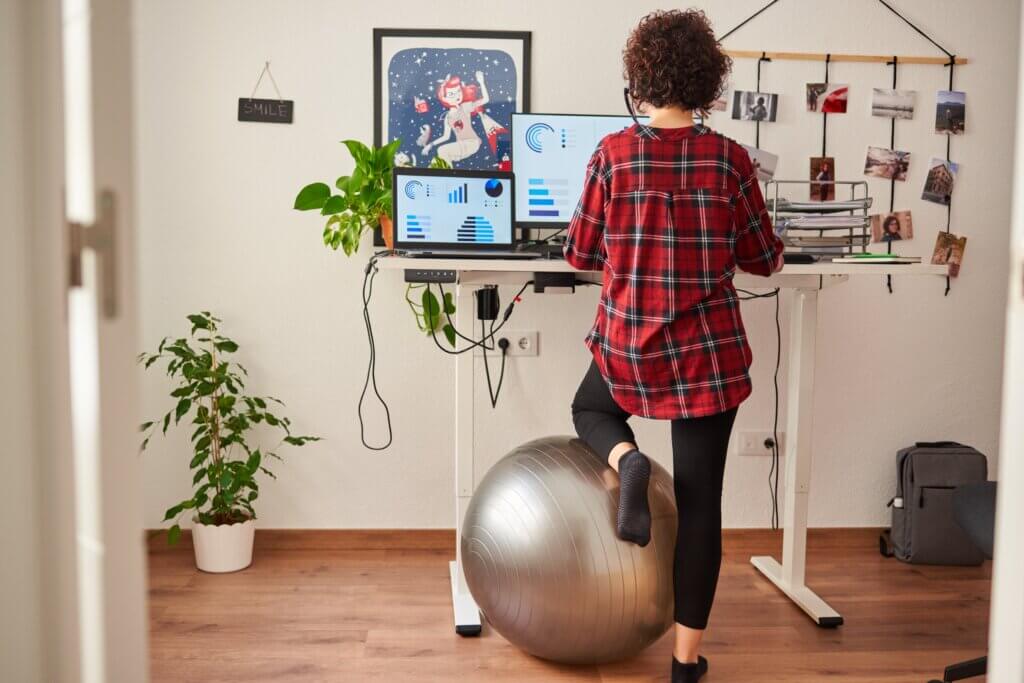Working Standing Up: A New Trend in Offices

For several years now, a new trend has taken hold in offices around the world: Working standing up. Popularized as an alternative to sedentary work, it’s an option that has also gained space in working from home. How beneficial is it? Are there associated risks? What do the experts say about working standing up? We’ll respond to all this and offer some reflections.
As the World Health Organization (WHO) points out, a sedentary lifestyle may well be among the top 10 causes of death and disability worldwide. Office work is eminently sedentary, so working standing up is emerging as a parallel option. Let’s see why it has been so popular and what to consider about it.
When was the trend of working standing up born?
It’s very difficult to trace when the trend of working standing began. In the first place, it’s important to remember that the practice has been practiced to a greater or lesser extent for centuries, and characters such as Winston Churchill, Pedro I of Russia, Ernest Hemingway, and Napoleon were known for doing so. However, when you think of working standing up, you think of it in relation to modern office work.
According to researchers, up to 75% of the entire workday is spent sitting down. To fight against this, alternatives have emerged, such as taking short breaks to stretch our legs and taking short walks. In this context, working standing up has established itself as an option to deal with the medium and long-term consequences of a sedentary lifestyle in the office.
In addition to fighting a sedentary lifestyle, standing work days have attracted millions of people due to the creation of informal workspaces. Along with this, the aesthetic aspect has also played in its favor. For this, special standing tables are used, which can be customized to the size of the worker or adjusted to different heights. Many can be used as conventional tables.
Finally, another variable that has contributed to its popularization has been the collaborative work groups. Moving from one workspace to another is much more intuitive and faster when there’s no chair in between, and many people can be in front of a computer or a work table without one. It has penetrated almost all corners of the world, with special importance in the United States, Europe, and some Asian countries.
The benefits of working standing up

There are some indications that working standing up has certain health benefits. A study published in the International Journal of Environmental Research and Public Health in 2021 found that workers on their feet report a significant increase in subjective health, vitality in work-related engagement, and self-reported job performance over a four-week trial period.
Similarly, there’s evidence that work performance is slightly higher when working standing up, but in longer shifts, it can cause musculoskeletal discomfort. Regarding the receptivity of workers, some studies and researchers have found a positive acceptance among them in a general way when assuming the alternative.
Other authors point out that the main benefit of working standing up is felt in the long-term awareness of the effects of sedentary work. Indeed, and although not all assume it as the main option, they do acquire greater mobility when assuming conventional office work. After all, seated work has been associated with heart, metabolic, inflammatory, and endocrine diseases.
Tips for Implementing Standing Work

Keep in mind that full days are related to certain complications. Back pain, fluid retention, and neck pain are some of them. Rather than implementing a full day of working standing up, it’s best to combine it with sitting work.
As Harvard Health Publishing rightly points out, it’s best to start with 30 or 60 minutes and gradually increase the time as appropriate. A sudden change in work style can produce more adverse effects than benefits, so even if it seems little to you, we suggest sticking to this time limit. As a complement, keep in mind the following to improve your posture :
- Make sure that the body is perfectly aligned with the desktop. This is, parallel with it.
- Your elbows should form a 90° angle in relation to the desk.
- Relax your shoulders and neck to prevent a buildup of muscle tension.
- Wear comfortable shoes without heels. If you wish, you can use an exercise mat as a support base.
- Tilt the computer screen so that it’s pointing directly at your eyes.
- Consider having a conventional desk or buying a desk that can be adjusted to fit both styles.
Finally, remember that standing up isn’t a substitute for regular exercise. Even when you work several hours in this position, you must do a minimum of 150 minutes of intense physical activity or 300 minutes of moderate activity throughout the week. If you can’t adjust to working standing up, don’t feel obligated, you can always find a way to include movement when working sitting at the desk.
For several years now, a new trend has taken hold in offices around the world: Working standing up. Popularized as an alternative to sedentary work, it’s an option that has also gained space in working from home. How beneficial is it? Are there associated risks? What do the experts say about working standing up? We’ll respond to all this and offer some reflections.
As the World Health Organization (WHO) points out, a sedentary lifestyle may well be among the top 10 causes of death and disability worldwide. Office work is eminently sedentary, so working standing up is emerging as a parallel option. Let’s see why it has been so popular and what to consider about it.
When was the trend of working standing up born?
It’s very difficult to trace when the trend of working standing began. In the first place, it’s important to remember that the practice has been practiced to a greater or lesser extent for centuries, and characters such as Winston Churchill, Pedro I of Russia, Ernest Hemingway, and Napoleon were known for doing so. However, when you think of working standing up, you think of it in relation to modern office work.
According to researchers, up to 75% of the entire workday is spent sitting down. To fight against this, alternatives have emerged, such as taking short breaks to stretch our legs and taking short walks. In this context, working standing up has established itself as an option to deal with the medium and long-term consequences of a sedentary lifestyle in the office.
In addition to fighting a sedentary lifestyle, standing work days have attracted millions of people due to the creation of informal workspaces. Along with this, the aesthetic aspect has also played in its favor. For this, special standing tables are used, which can be customized to the size of the worker or adjusted to different heights. Many can be used as conventional tables.
Finally, another variable that has contributed to its popularization has been the collaborative work groups. Moving from one workspace to another is much more intuitive and faster when there’s no chair in between, and many people can be in front of a computer or a work table without one. It has penetrated almost all corners of the world, with special importance in the United States, Europe, and some Asian countries.
The benefits of working standing up

There are some indications that working standing up has certain health benefits. A study published in the International Journal of Environmental Research and Public Health in 2021 found that workers on their feet report a significant increase in subjective health, vitality in work-related engagement, and self-reported job performance over a four-week trial period.
Similarly, there’s evidence that work performance is slightly higher when working standing up, but in longer shifts, it can cause musculoskeletal discomfort. Regarding the receptivity of workers, some studies and researchers have found a positive acceptance among them in a general way when assuming the alternative.
Other authors point out that the main benefit of working standing up is felt in the long-term awareness of the effects of sedentary work. Indeed, and although not all assume it as the main option, they do acquire greater mobility when assuming conventional office work. After all, seated work has been associated with heart, metabolic, inflammatory, and endocrine diseases.
Tips for Implementing Standing Work

Keep in mind that full days are related to certain complications. Back pain, fluid retention, and neck pain are some of them. Rather than implementing a full day of working standing up, it’s best to combine it with sitting work.
As Harvard Health Publishing rightly points out, it’s best to start with 30 or 60 minutes and gradually increase the time as appropriate. A sudden change in work style can produce more adverse effects than benefits, so even if it seems little to you, we suggest sticking to this time limit. As a complement, keep in mind the following to improve your posture :
- Make sure that the body is perfectly aligned with the desktop. This is, parallel with it.
- Your elbows should form a 90° angle in relation to the desk.
- Relax your shoulders and neck to prevent a buildup of muscle tension.
- Wear comfortable shoes without heels. If you wish, you can use an exercise mat as a support base.
- Tilt the computer screen so that it’s pointing directly at your eyes.
- Consider having a conventional desk or buying a desk that can be adjusted to fit both styles.
Finally, remember that standing up isn’t a substitute for regular exercise. Even when you work several hours in this position, you must do a minimum of 150 minutes of intense physical activity or 300 minutes of moderate activity throughout the week. If you can’t adjust to working standing up, don’t feel obligated, you can always find a way to include movement when working sitting at the desk.
- Chau JY, Daley M, Srinivasan A, Dunn S, Bauman AE, van der Ploeg HP. Desk-based workers’ perspectives on using sit-stand workstations: a qualitative analysis of the Stand@Work study. BMC Public Health. 2014 Jul 25;14:752.
- Dutta N, Walton T, Pereira MA. One-year follow-up of a sit-stand workstation intervention to decrease sedentary time in office workers. Prev Med Rep. 2019 Jan 16;13:277-280.
- Ebara T, Kubo T, Inoue T, Murasaki GI, Takeyama H, Sato T, Suzumura H, Niwa S, Takanishi T, Tachi N, Itani T. Effects of adjustable sit-stand VDT workstations on workers’ musculoskeletal discomfort, alertness and performance. Ind Health. 2008 Oct;46(5):497-505.
- Gradidge P, Phaswana M, Wijndaele K, Crowther N, Draper C. Standing up against office sitting: A study protocol. S Afr J Physiother. 2020 Sep 4;76(1):1415.
- Grunseit AC, Chau JY, van der Ploeg HP, Bauman A. “Thinking on your feet”: A qualitative evaluation of sit-stand desks in an Australian workplace. BMC Public Health. 2013 Apr 18;13:365.
- Ma J, Ma D, Li Z, Kim H. Effects of a Workplace Sit-Stand Desk Intervention on Health and Productivity. Int J Environ Res Public Health. 2021 Nov 4;18(21):11604.
- Straker, L., Healy, G., Atherton, R., & Dunstan, D. Excessive occupational sitting is not a” safe system of work”: time for doctors to get chatting with patients. Medical Journal of Australia. 2014: 3: 138-140.
Este texto se ofrece únicamente con propósitos informativos y no reemplaza la consulta con un profesional. Ante dudas, consulta a tu especialista.







